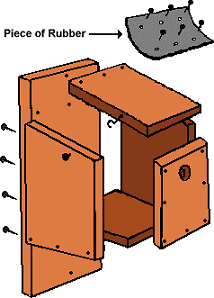
|

|
|
 Sent
to you Sent
to you
by e-mail
|
|
Simply
enter your details and hit the send button
more
info |
|


Click Here

Links
Advertise
Terms of Use
Contributors
About Us
Contact Us
|
 |
Go back
 | Bookmark
| Bookmark
 | Print Page
| Print Page  | E-Mail Us
| E-Mail Us 



|
|
UK
Safari Tip:
It's best not to use any treatment on the wood, but if you decide
to use a preservative, make sure it's harmless to animals
|
|
It can be very enjoyable to watch birds nesting and rearing their young, and a
nest box gives you a good opportunity to observe all the action. First you'll see the parents taking in nest building materials, and then later you can watch them bringing food for the chicks. Finally, if you are lucky, you'll witness the young birds leaving the nest on their first precarious flight.
Depending on where you live, the type of birds that may use your nest box include; blue tits, great tits, house sparrows, tree sparrows and nuthatches.
January is a good time to build and set up your nest box ready for the spring. It will give the birds time to get used to it and give you more chances to attract a breeding pair.
To build
your nest box you will need a plank approximately 15cms wide, 1.5cms thick and 142.4cms long.
 With a pencil and rule, measure and mark out the plank as shown in the diagram
(left) then cut the sections with a saw.
With a pencil and rule, measure and mark out the plank as shown in the diagram
(left) then cut the sections with a saw.
The hole in the front panel (the entrance) needs to be at least 12cms from the base of the box, otherwise a cat could put its paw inside to scoop the birds out. The diameter of the entrance hole varies depending on the species you want to attract. Blue tits require a 2.7cm hole, great tits require a 3cm hole, and tree sparrows and nuthatches will need a 3.2cm hole. Use a brace and bit to cut the hole.
 Join the panels together with galvanised nails or wood screws. Use a piece of rubber for the hinge on the lid (an old inner tube is good for this), and a strong catch is important to stop predators getting inside. You could use a piece of wire wound around the heads of two screws.
Join the panels together with galvanised nails or wood screws. Use a piece of rubber for the hinge on the lid (an old inner tube is good for this), and a strong catch is important to stop predators getting inside. You could use a piece of wire wound around the heads of two screws.
If you treat the wood with preservative make sure it's harmless to animals.
It is best to position the box so that it faces north-east or south east. This will keep the entrance away from strong sunlight and wet weather.
Once a year, around autumn time, clear out any nesting material inside, as this can harbour parasites which could infect the next years occupants. Other than this annual clean, the
nest box should not be disturbed. Simply watch the activities from a
distance.

UK Safari Gardening for Wildlife Section
|
 |

|